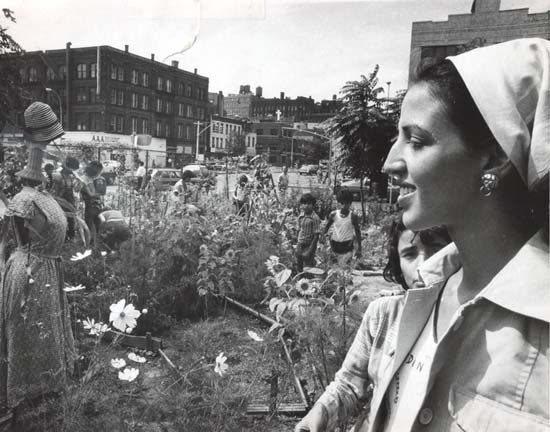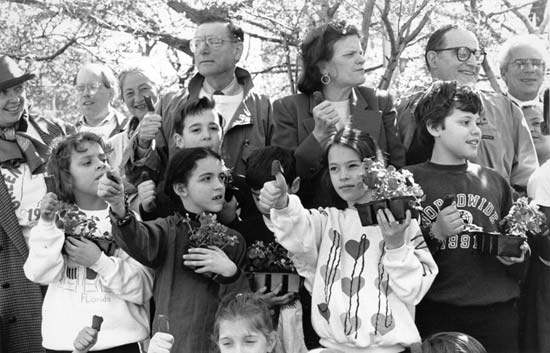History of the Community Garden Movement
Find information about NYC's community gardens on the GreenThumb website.
Green Guerrillas Gain Ground
1975 image of Liz Christy in one of her Lower East Side gardens. Courtesy of Donald Loggins
After the top-down emphasis in the management style of Parks Commissioner Robert Moses (1934-60), the 1960s heralded a new era of community input and outreach by the Parks Department, especially during the administration of Thomas Hoving. Hoving's inclusive style and the vestpocket park campaign that sought to quickly transform vacant lots into usable open space (often soliciting help and advice from local residents) helped change the tone of park administration during this era. This shift coupled with the severe fiscal crisis of the early 1970s paved the way for the Community Garden movement of the 1970s, which began in earnest on the Lower East Side with the Green Guerillas.
During the financial crisis of the 1970s, many parts of the city suffered, and vacant and abandoned lots—both public land and newly public land acquired by foreclosure— were endemic. Abandoned buildings, if they weren't already torn down, dotted the landscape, especially in Manhattan neighborhoods such as the Lower East Side, Hell's Kitchen, and East Harlem, and underutilized land sat fallow amidst widespread urban neglect. A nonprofit environmental group dedicated to preserving urban gardens, the Green Guerillas, started in 1973 by lobbing "seed bombs" packed with fertilizer, seed, and water over fences around vacant lots where access was otherwise limited in an attempt to beautify some of these eyesores with greenery. This move not only beautified formerly vacant lots but soon became a grassroots program that fostered neighborhood participation.
Liz Christy was a founder of Green Guerrillas. Christy lived on Mott Street on the Lower East Side of Manhattan, and together with other volunteers spent a year removing trash, adding topsoil, installing fencing, and otherwise beautifying a lot on the northeast corner of Bowery and Houston streets. In April 1974, the City Office of Housing Preservation and Development approved a lease for $1 a month for what was called the "Bowery Houston Community Farm and Garden," becoming the first community garden in the city. Gardeners built 60 vegetable beds, eventually adding trees to the site.
As the garden began attracting attention and winning awards, the Green Guerillas started running workshops and experimenting with sturdy plants that could stand up to a hostile city environment. The group shared that which was grown on site and donated plants with other gardens across the city. In 1986, the Garden was dedicated Liz Christy's Bowery-Houston Garden, in memory of Christy, who died of cancer in 1985.
Cultivating a City Program
Officials and children proudly display their green thumbs. Courtesy of Donald Loggins
Realizing the wisdom of outsourcing the maintenance of vacant city–owned lots to energetic community groups willing to tend to them and wanting to encourage grassroots neighborhood revitalization efforts, the City initiated the GreenThumb program in 1978 to provide assistance and coordination. Originally sponsored by the City Department of General Services and funded by federal Housing and Urban Development Community Development Block Grants (GreenThumb is still funded largely by community block grants from the federal Housing and Urban Development program), GreenThumb coordinated the leases for city–owned vacant land. Whether through vegetable plots or lush flower or herb gardens, residents transformed unattractive and sometimes unsafe spaces into green havens, providing open space in especially underserved areas.
In the beginning, the city allowed neighborhood groups to use parcels for a token lease, sometimes just $1 a year. As the GreenThumb program became more established and partnerships between the city and community groups strengthened, this arrangement shifted to a licensing agreement. Although the gardens were strictly temporary, and the city reserved the right to develop vacant lots, the community gardens became important institutions, and many of the sites remained as gardens despite the pressure to build housing or other infrastructure. As Mayor Ed Koch, who as mayor of New York from 1978 to 1989 presided over a great expansion of community gardens, said to Parks' own It's My Park television show, "some of them have become absolutely necessary and add back to the value of a whole neighborhood."
In 1984, GreenThumb established the Garden Preservation Program and introduced ten–year leases. In 1989, a "preservation site" designation was introduced, whereby the City Land Committee conferred a special status to sites for permanent use as community gardens as long as they were actively maintained. That designation became unnecessary in 1995 when GreenThumb fell under the jurisdiction of the Parks Department, further solidifying the permanent status of community garden sites; GreenThumb now licenses parcels to groups and works with them to ensure that standards are met and the gardens are open to the communities in which they are sited.
In the 1990s, the City indicated that it was looking at selling many of the community garden sites to developers for housing and commercial opportunities. The battle between development and preserving open space, a perennial tension in cities across the world and not limited just to community gardens in New York, culminated in an agreement brokered by then–Attorney General Eliot Spitzer and the City to preserve more than 400 sites across the five boroughs, either leaving them under the jurisdiction of City agencies or transferring them to the Parks Department. (That left approximately 150 parcels open to eventual development for New York's housing needs.) The nonprofit New York Restoration Project (NYRP) was instrumental in preserving these sites, organizing in 1999 to protect gardens across the city, and in more than 50 instances buying the parcels to preserve them in perpetuity. Entertainer Bette Midler helped found NYRP in 1995 and has brought together neighborhood groups, city agencies, and even noted landscape architects to highlight the importance of open space in communities. The group works to remove debris from sites (especially in Northern Manhattan) and restore parcels of land, assist community gardens and gardeners, and raise funds to support these goals. The Trust for Public Land, a national organization devoted to preserving open spaces, is another outside group that works to assist community gardens in the city.
In Full Bloom
Today GreenThumb is the nation's largest urban gardening program, providing assistance and support to more than 550 gardens and 20,000 garden members throughout the city. In fact, community gardens account for more than 100 acres of public open space in the city. Most community gardens are the size of a single lot (just a fraction of an acre), but there are a few like Liz Christy Garden that have blossomed into over one acre.
In addition to helping groups purchase plants, the GreenThumb program also provides materials such as tools and mulch and technical assistance like educational workshops. The sites are further beautified by local artists, either with murals or sculptural elements. GreenThumb is also working with gardens on environmental initiatives such as capturing rainwater; it currently has 36 rainwater collection systems operating in gardens and has received funding to expand the program.
For gardeners, "getting a key" to a community garden is a proud moment, and tending a plot in a crowded part of the city provides a sense of ownership that is sometimes absent for those who rent, especially in some of the city's rapidly changing neighborhoods. Community gardens often have their own by–laws and rules. For example, "Thou Shalt Not Shade" is on Clinton Community Garden's list of commandments: "Trees are NOT permitted in garden plots. Root systems can be extensive. Even dwarf species have roots that can spread underground to a neighbor's plot, leaching the soil of nutrients and moisture. Leaves, of course, block the sunlight."
All community gardens program events at their spaces, and many have their own websites.
The best way to find out about community gardens in your neighborhood is to get out and find them; they're all over! Gardens will post opening hours for members of the public interested in finding out what goes on or just wanting to enjoy a patch of green space in their neighborhood, and there are often outreach events going on. Volunteer opportunities abound, and there is often a plot available for you to use should you decide to participate.

